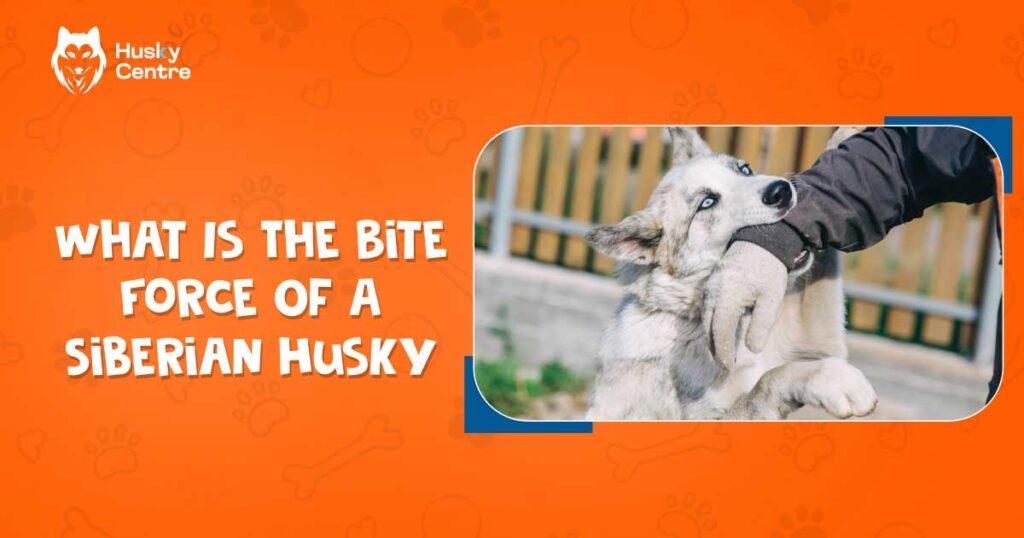The bite force of a Siberian Husky measures around 320 PSI. This makes it a relatively strong bite among dog breeds.
Siberian Huskies are known for their strength, endurance, and striking appearance. Originating from Siberia, they were bred for pulling sleds over long distances. Their powerful bite force of 320 PSI is reflective of their robust build and strong jaws. While not the strongest bite among dogs, it is significant enough to highlight their physical capabilities.
Siberian Huskies are also celebrated for their friendly temperament and high energy levels. They make excellent companions for active families. Training and socialization are essential for these intelligent and independent dogs. Overall, their unique combination of strength, beauty, and friendly nature makes them a popular choice among dog enthusiasts.
Overview Of Siberian Husky Breed
The Siberian Husky is a fascinating breed, admired for its striking appearance and friendly nature. One intriguing aspect of this breed is its bite force.
Understanding the bite force of a Siberian Husky requires knowing more about the breed itself. This overview provides insights into the Siberian Husky’s origin, physical traits, and temperament.
Origin And History
The Siberian Husky originated in Northeast Asia. The Chukchi people bred them for sled-pulling and companionship. They needed dogs that could withstand harsh climates. Huskies are known for their endurance and resilience.
Physical Traits
Siberian Huskies have a unique appearance. They are medium-sized dogs with a strong build. Their fur is thick and double-layered, helping them stay warm in cold weather. Their eyes can be blue, brown, or even one of each, adding to their distinct look.
| Feature | Description |
| Size | Medium |
| Weight | 35-60 lbs |
| Coat | Thick, double-layered |
| Eye Color | Blue, brown, or heterochromatic |
Temperament
Siberian Huskies are known for their friendly and gentle nature. They are playful and enjoy human company.
These dogs are also intelligent and independent, which can sometimes make training a challenge. They are not usually aggressive, making them great family pets.
Exercise Needs
Huskies are high-energy dogs. They require a lot of physical activity to stay happy and healthy. Daily exercise is essential for this breed.
Activities such as running, hiking, and playing fetch are ideal for them. Without enough exercise, they can become bored and destructive.
Health And Lifespan
Siberian Huskies are generally healthy dogs. They have a lifespan of about 12-15 years. Regular vet check-ups and a balanced diet can help maintain their health. Common health issues include hip dysplasia and eye conditions.
Importance Of Understanding Bite Force
Siberian Huskies are known for their striking looks and energetic nature. But there’s more to these magnificent dogs than their appearance. One interesting aspect is their bite force. Understanding the bite force of a Siberian Husky is crucial for several reasons.
Knowing the bite force of a Siberian Husky helps in training and safety. It ensures that owners can handle their dogs properly. A strong bite force can cause damage if not controlled.
Training And Behavior Management
A Siberian Husky’s bite force can affect its behavior. Proper training helps in managing this force. It ensures a well-behaved dog. Training should include bite inhibition techniques.
Safety For Family And Others
Understanding bite force is important for family safety. Children should be taught to respect the dog’s space. This knowledge helps in preventing accidents. Safety precautions should always be in place.
Comparing Bite Force With Other Breeds
Comparing a Siberian Husky’s bite force with other breeds gives perspective. Below is a table comparing bite forces of common dog breeds:
| Breed | Bite Force (PSI) |
| Siberian Husky | 320 PSI |
| German Shepherd | 238 PSI |
| Rottweiler | 328 PSI |
| American Pit Bull | 235 PSI |
Equipment And Toys
Strong bite force affects the choice of toys and equipment. Toys should be durable to withstand their bites. Chew toys help in keeping their teeth healthy and strong.
Veterinary Care
Bite force also affects dental health. Regular vet check-ups ensure that their teeth and jaws are healthy. Proper care can prevent dental issues.
Bite Force Explained
Have you ever wondered how strong a Siberian Husky’s bite is? Understanding the bite force of a Siberian Husky can help us appreciate the strength and power of these majestic animals. In this section, we will explain what bite force means and how it is measured.
Definition Of Bite Force
Bite force refers to the amount of pressure exerted by the jaws when an animal bites. It is usually measured in pounds per square inch (psi). This measurement helps in understanding the power and strength of an animal’s jaw muscles.
Bite force is important for several reasons:
- Hunting and Survival: For wild animals, a strong bite force is crucial for hunting and protecting themselves.
- Feeding: It helps in breaking down food into smaller, manageable pieces.
- Defense: A strong bite can be a powerful defense mechanism.
Siberian Huskies have a moderate bite force compared to other dog breeds. This is due to their muscular jaws and sturdy skulls. While they are not the strongest biters, their bite force is still impressive.
Here is a quick comparison of bite forces among different dog breeds:
| Dog Breed | Bite Force (psi) |
| Siberian Husky | 320 psi |
| German Shepherd | 238 psi |
| Rottweiler | 328 psi |
| Kangal | 743 psi |
How Bite Force Is Measured
Measuring bite force involves specialized tools and techniques. Scientists use devices called force gauges or bite force meters to measure the pressure exerted by an animal’s bite.
The process typically includes the following steps:
- Preparation: The animal is prepared and calmed to ensure accurate measurement.
- Device Placement: The bite force meter is placed in the animal’s mouth.
- Bite Recording: The animal is encouraged to bite down on the device.
- Data Collection: The device records the pressure exerted during the bite.
Here is a simple breakdown of the tools used:
| Tool | Description |
| Force Gauge | Measures the force applied during the bite. |
| Bite Force Meter | A specialized device for recording bite pressure. |
These measurements are crucial for scientific studies and understanding animal behavior. They help in assessing the strength and health of an animal’s jaw muscles. For Siberian Huskies, bite force measurement aids in training and ensuring their well-being.
Siberian Husky Bite Force
The bite force of a Siberian Husky is a fascinating topic for dog enthusiasts and potential owners. Understanding the Siberian Husky bite force can help in comprehending their capabilities, behavior, and how to handle them safely.
This section dives deep into the specifics of the Husky bite force and how it compares with other breeds.
Specifics Of Husky Bite Force
The bite force of a Siberian Husky is measured in pounds per square inch (PSI). On average, a Siberian Husky has a bite force of around 320 PSI. This is a significant amount of pressure, considering their medium size.
Key factors influencing the Husky’s bite force include:
- Jaw Structure: Huskies have strong jaws designed for gripping and holding.
- Muscle Strength: Their muscular build contributes to their powerful bite.
- Teeth Alignment: Proper teeth alignment enhances their biting efficiency.
Here is a table summarizing some of the specifics:
| Factor | Details |
| Average Bite Force | 320 PSI |
| Jaw Structure | Strong and robust |
| Muscle Strength | Highly muscular |
| Teeth Alignment | Optimal for biting |
Understanding these details helps in appreciating the power and capability of this breed. Proper training and handling are essential to ensure safety and good behavior.
Comparisons With Other Breeds
Comparing the Siberian Husky bite force with other breeds provides a clearer perspective. Below are some examples:
- German Shepherd: Bite force around 238 PSI.
- Rottweiler: Bite force approximately 328 PSI.
- American Pit Bull Terrier: Bite force roughly 235 PSI.
From the comparison, it’s evident that the Siberian Husky has a stronger bite than many popular breeds. The Rottweiler is one of the few breeds with a slightly higher bite force.
Here is a comparative table:
| Breed | Bite Force (PSI) |
| Siberian Husky | 320 |
| German Shepherd | 238 |
| Rottweiler | 328 |
| American Pit Bull Terrier | 235 |
These comparisons highlight the Siberian Husky’s impressive bite force. Knowing this can help in understanding their behavior and the need for proper training. It also emphasizes the importance of responsible ownership.
Behavior And Temperament
The Siberian Husky is a majestic and energetic breed known for its strength and endurance. Understanding the behavior and temperament of a Siberian Husky is crucial, especially when considering their impressive bite force.
These dogs are generally friendly and playful but can exhibit strong-willed and independent traits. Knowing how to manage their behavior helps ensure they are well-behaved family pets.
Aggression Levels In Huskies
Siberian Huskies are typically not aggressive. They are known for their gentle and friendly nature. However, like any dog, they can show signs of aggression in certain situations. Here are some factors that may influence aggression levels in Huskies:
- Lack of socialization: Dogs not exposed to various environments, people, and other animals may become fearful or aggressive.
- Resource guarding: Some Huskies might guard their food, toys, or space, leading to aggressive behavior.
- Fear and anxiety: Situations that cause fear can trigger aggression as a defensive mechanism.
It’s essential to recognize and address these behaviors early to prevent escalation. A well-socialized Husky is less likely to display aggressive tendencies. Regular interaction with other dogs and people helps them become more comfortable and less fearful.
Aggression can sometimes be misunderstood. A Husky may show signs of dominance or territorial behavior, which owners might misinterpret as aggression. Understanding these nuances is key to managing their behavior effectively.
Proper Training To Manage Bite Force
Training a Siberian Husky to manage its bite force is vital for ensuring safety. Here are some effective training techniques:
- Start early: Begin training when the Husky is a puppy. Early training helps establish good habits and behaviors.
- Positive reinforcement: Use treats and praise to reward good behavior. This method encourages the dog to repeat desired actions.
- Bite inhibition: Teach the dog to control the force of its bite. Play games that promote gentle mouthing and discourage hard bites.
- Obedience training: Commands like “sit,” “stay,” and “leave it” help manage the dog’s behavior and prevent unwanted biting.
Consistency is critical in training. Ensure all family members follow the same training methods to avoid confusing the dog. Regular practice and patience are necessary for success.
Incorporating socialization into the training routine is also beneficial. Exposing the Husky to various scenarios helps them remain calm and composed, reducing the likelihood of aggressive biting. Training classes can provide a structured environment for socialization and learning.
Frequently Asked Questions
Do Huskies Have A Strong Bite Force?
Yes, huskies have a strong bite force. Their bite force measures around 320 PSI, which is quite powerful.
Do Huskies Bite Hard?
Yes, huskies can bite hard. Their bite force is around 320 PSI. Proper training and socialization reduce biting tendencies.
Which Dog Breed Has The Strongest Bite Force?
The Kangal dog breed has the strongest bite force. Their bite force measures around 743 PSI, making them the top breed in this category.
Can A Husky Beat A Pitbull?
A Husky and a Pitbull are different breeds with unique strengths. Fight outcomes depend on individual dogs, not breeds.
Conclusion
Understanding the bite force of a Siberian Husky helps appreciate their strength and behavior. These dogs possess a powerful bite, reflecting their strong and resilient nature. Always ensure proper training and socialization for a safe and happy relationship. Learn more about Huskies to provide the best care for them.


Meet Jarred, the heart and soul behind HukyCentre. With a deep affection for furry friends, he pours his passion into every word he writes. His genuine love for dogs shines through in his engaging and informative content. As a dedicated dog enthusiast, Jarred’s goal is to share valuable insights and tips that resonate with fellow dog lovers. Join Jarred on the journey as he celebrates the joy and companionship that dogs bring into our lives.



